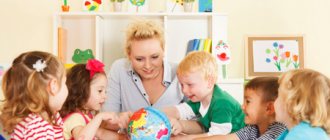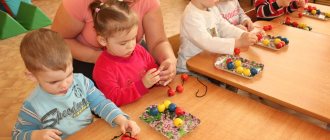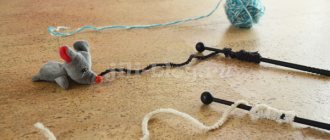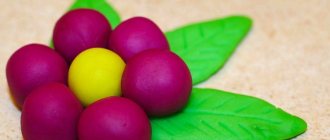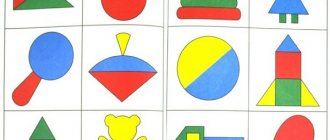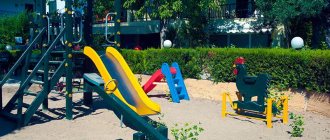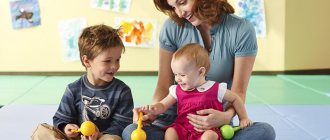Features of this age
Surely every mother or father has already noticed that the child’s coordination has improved significantly, the baby very rarely falls “out of the blue,” and games have become much more meaningful. It's time to introduce the baby to toys - sorters, a large construction set, a pyramid. Large magnetic puzzles and wooden games for learning shapes and colors are perfect for developing motor skills in children aged 1-2 years.
A feature of the development of a 2-year-old child is the improvement of logical thinking. The baby is actively exploring the world, he is interested in finding solutions to various problems on his own, and his favorite pastime is helping his family with household chores. It is important to support the baby in this endeavor, allow him to help with vacuuming, washing dishes, and choosing his own clothes according to the weather. Even if such help resembles pampering, in the future you won’t have to force the baby to collect toys and things.
Surely the first toys have already been broken and disassembled - the child is interested in the question “how does it work.” The technique arouses great curiosity; it is recommended to tell the child as much as possible, show simplified diagrams and cards.
Football is great for physical development. Kicking a ball with your daughter or son in the yard is an excellent training for your sense of space, physical endurance, accuracy, and coordination. Let such development of a child at just 2 years old seem unnecessary or strange to you, but research shows that already at this age, it is versatile activities that are useful. Today we kick a ball, tomorrow there will be modeling, the day after tomorrow we learn to draw, the next day we glue the first appliqués.
Advice: Your calm, diligent baby is about to become a bully and begin to say “no” to everything. The three-year crisis is approaching. Daily varied activities will help both you and your baby get through this difficult time much more smoothly.
Developmental activities at home with mom, exercises for every day
The task of parents is to spend as much time as possible with the child and organize his leisure time. First of all, you need to start classes with hand motor skills. It is necessary to get your child interested in building houses from cubes. You should start with the simplest figures, gradually increasing complexity. It is important to constantly talk to the children during the game and explain every action of the owl. There must be praise.
Children aged two to three years show great interest in household chores. Don't discourage yourself from helping your mom. You can invite your baby to sweep or wipe off the dust themselves. You should always invite your child to help their parents. If you don’t do this, you will have to force him at an older age.
Some parents prefer to hire professional nannies to work with their children. This is a big mistake. At an early age, a baby really needs to communicate with his mother. Any exciting game unites and brings parents and children closer together. It is very useful to play with the whole family.
Important! It is recommended not just to select activities, but to focus on the child’s specific abilities. It is best to alternate creative games with active ones. It is important to observe the time of the classes; they should be no more than twenty minutes. It is still very difficult for children to concentrate on one subject for a long time.
What should a child be able to do by the age of two?
Most often, the level of development of a 2-year-old child allows him to run quite quickly, climb stairs, and easily overcome low obstacles. Many children are particularly “climbing” in this period of life, and don’t feed them bread, let them climb somewhere higher.
From games, complex buildings made from cubes are perfectly mastered: towers, pyramids, structures that are strange for adults, reminiscent of fortresses. The pyramid should also be well studied. The child should be able to easily assemble it from the larger ring to the smaller one. Games with the ball become more mature: the child catches it with both hands, knows how to kick and throw it in the right direction.
Games take on a plot; this is especially easy to understand if you watch a child in a group. The baby prepares lunches in the sandbox, feeds toys, and may try to feed his peers. The baby should already be able to drink and eat on his own, without excessive waste of food from a spoon. It is better for the development of the child, by 1.5 or 2.5 in extreme cases, to seat him for lunch at a small children's table. This is a great start to preparing for kindergarten.
What else should a child be able to do:
- provide age-appropriate help around the house;
- be able to use not only a spoon, but also a fork;
- understand and respond to requests, stories, questions, suggestions;
- ask questions when parents read books or show cartoons;
- know most body parts of yourself, others, animals;
- know at least 100 words and pronounce them; Slightly poor pronunciation is acceptable at this age;
- make short sentences;
- use the pot for needs;
- be able to study with cards, books, pronounce words after adults;
- know animal sounds;
- try to draw, distinguish between several colors;
- knows what “impossible” and “dangerous” are.
Tip: Your baby is active. To prevent flat feet, it is recommended to purchase special massage mats and place them in the place where the baby runs most often during the day. For example, in the corridor. If you are passionate about handicrafts, such a rug is easy to make yourself: buttons, beads, pieces of fabric of various densities, and caps from felt-tip pens are sewn onto thick fabric. These rugs are recommended for use from 1.5 years.
Physical development
For the physical correct development of a child at 2 years old, there are hundreds of recommendations, disputes about which will never subside. We recommend, first of all, that you closely monitor your child:
- If your baby runs, jumps a lot, and loves outdoor games, your only task is to provide him with the conditions for this. Walk more, come up with fun games, do morning exercises in the morning.
- If the baby is a leisurely child who prefers calmer games, then you can choose games that will simultaneously train him and not push him away with excessive activity. On the street you can collect pine cones or flowers in a basket, walk back and forth along the curb, or play tag.
Advice: In 100 cases out of 100, the child is infected by the parents’ lifestyle. If you prefer to spend extra time sitting at the computer or with a phone in your hand, rest assured that your child will love what you love. If mom and dad do exercises, jogging and don’t have bad habits, this will also become a standard of life behavior for the baby. The bad parent is the one who demands from the child what he himself does not do.
Developing baby's speech
At two years old, your child should not only know the name of an object, but also give a short description of it. Ask them to tell you as often as possible what the baby saw and retell the fairy tales you read. To do this, it is necessary to conduct thematic classes with the child. 2 years is the age when children are inquisitive and love to listen and watch. While reading stories, analyze what is happening. You can use finger puppets. Do little theater shows with questions and answers.
For example, when reading a fairy tale, skip a word and ask your child to add his own words that fit the meaning. Do the same with poems - let the child say the ending. Always use facial expressions and body movements when telling another interesting story. Children love when there is some action. Toys, cardboard cutouts and dolls make great characters for your stories.
After each book you read, ask questions about the content. Let the child develop attentiveness and memory. Pay attention to little things and details. When reading dialogues, always change the voices. The child must imagine all the characters in detail. Also ask him to retell the story - let him use facial expressions and voice.
Exercises and games for physical development at 2 years old
We recommend several games for a 2-year-old child for physical development, mental training and mobility:
- Draw on cards or print out pictures and scatter apples, mushrooms, berries on the floor and collect them with your child. Be sure to pronounce the names of all objects in the pictures. This exercise will not only force the baby to squat and bend over, but will also enrich his vocabulary.
- We repeat after the animals. Show your child how a snake crawls, how an ostrich runs, how a cat, how an elephant. The space here is enormous. Do not hesitate to show by example and forgive your child to repeat.
- On the street, walk more on objects: on the parallel bars on the sports ground, along curbs. Modern playgrounds provide space for children's games and development. There are horizontal bars, ladders, a climbing wall, tunnels, and much more.
- Games with fitball are a great workout not only for adults, but also for children. It’s fun to jump on it; you can make an analogy with a trampoline, if an adult presses it with his knees to the sofa or into the corner of the walls, and, supporting the child, lets him jump to his heart’s content.
Sound environment
A good suggestion is to play with your baby to recognize sounds and surrounding space. You should listen carefully to the ticking of a clock, the buzzing of a fly, the noise of cars outside the window. When explaining to your child the origin of sounds, it is advisable to repeat them together. You can become the source of sound yourself: scratch your nails on the wall, glass, slam the door, cough, pretend what sounds pets make. By repeating after an adult, the child perceives less extraneous noise when going to bed and falling asleep.
Sensory development
For sensory development in children 2-3 years old, sensory boxes are ideal for use. To make such a simulator, you need to allocate a large container that can be filled with colored cereals, orbiz (this is a hydrogel that is not expensive, but its benefits are enormous), and sand. Stores offer an abundance of various fillers for sensory boxes: orbiz can be bought at a flower shop, ordered from China, or looked for in children's stores. You can buy kinetic sand or “smart” modeling clay. Give your child such a box, a couple of small molds, spatulas and a rake, bury new small toys in the filling and the child will be busy for a good 20-40 minutes.
Games for the sensory development of a 2-year-old child - space for the imagination of moms and dads. Be sure to let your baby participate in cooking. Show the potato in the skin, let him touch it, then peel it and give it to the child again. Then cut - again let's feel the pieces. Such a simple, everyday thing, but its effectiveness is amazing.
Also an excellent training tool would be a bag where you can put toys of different shapes and sizes and ask the child to take out first the large one, then the medium one, the rough one, the soft one, and so on. Modern special books for children can become a wonderful simulator for developing tactile sensations. In such books, for example, a tiger is shown on the page, and there is an insert with artificial tiger fur. You can touch it and study it. Such books cause wild delight in children.
Fine motor skills
For the development of fine motor skills in children 2 years old, large buttons, colored pasta, and sensory boxes, which we already discussed a little higher, are suitable. Give your child a string and a handful of colored pasta and show him how to make fancy beads if you have a girl and a bunch of gun cartridges if you have a boy.
Massage is perfect for finger development. Gently massage each finger in turn and play magpie-crow. Try to teach your child to fasten his own buttons as soon as possible. Speech therapists advise giving your child buckwheat mixed with rice or peas. It is not necessary for the child to do this for 20 minutes. 5-7 minutes is enough.
Games that develop fine motor skills:
- modeling with plasticine, clay, salt dough;
- It is useful to stick plasticine or paste onto stencils and drawings;
- appliques, working with scissors - an excellent simulator;
- games with clothespins, clamps;
- games with cereals, busy boards;
- putting together puzzles, sorting out magnets of different shapes on the refrigerator;
- The new magnetic construction set performed well.
Tip: How to color cereals or pasta? Dissolve food coloring in 3-6 ml of water in a container. Add cereal or pasta. Gently shake and scatter on a table covered with cling film or a bag to dry for 10 hours.
The more independent a child is, the less likely it is that a child will be developmentally delayed at 2 years of age. Allow him to do everything that is not dangerous to his health and well-being. If a baby climbs a hill, it is better to insure than to prohibit it. If he wants to help clean up, give him a broom or vacuum cleaner. If your hands reach for the food cupboard, pour a couple of handfuls of cereal into the container and tell them how to cook the porridge. Everything is important for finger motor skills: every movement trains the fingers in one way or another, develops muscles and tenacity.
Classes on studying the properties of objects
People encounter different things throughout their lives. And knowing their properties, it is easy to decide on their use. In order for a child to learn the properties of objects, they need to be memorized. Simultaneously with familiarization with the properties of objects, abstract thinking, touch and smell develop, and the baby learns comparison. The child learns the definitions of objects (wide - narrow, short - long, low - high); the sense of touch develops (smooth - rough, cold - hot, soft - hard); the sense of smell is improved (detecting differences in the smells and tastes of different products).
Musical and creative development
The scope for such activities is so diverse that they are limited only by the imagination of mom and dad. To train musical development, it is better for mother to sing songs and cradle songs more often. You can play musical cartoons for your child. Children from 1 year old love music books and toys. It is useful to dance together to fast music and slow music. Learning a dance has a good effect on memory and develops hearing. You can also find and download sounds of nature on the Internet, print out pictures and tell how a bear screams, how a wolf howls, how the sea roars, and so on.
There are a lot of interesting activities for the creative development of a 2-year-old child:
- Paint with finger paints. Cover the floor with newspapers and place whatman paper in the center. It is better to put your baby in home clothes and indulge in joint creativity without fear that the baby will ruin the clothes.
- Sharpen shavings from wax crayons. Ask your child to arrange the shavings on a sheet of paper the way he likes. Place another sheet on top, cover with a cloth and iron. Then open the creation and decorate your wall or refrigerator with it.
- Freeze the water and dyes in ice cube trays by inserting a toothpick or matchstick into each cube. Drawing with ice is an amazing, interesting leisure activity.
- Modeling, appliques, crafts from leaves and flowers, salt dough - all this will help the creative development of children aged 2-3 years.
Tip: To make safe finger paints, mix vegetable oil, flour or starch and water to create a gouache consistency. Add dyes and pour into jars.
Speech development of a child
Speech development of a child at 2 years of age is an extremely important stage of development. Every day, the vocabulary should be constantly replenished; books, pictures for the development of speech of a two-year-old, cartoons are helpful, but the main thing is communication with family and friends.
Speech therapy gymnastics, exercises for speech development in children 2 years old:
- Hippo. For this simple speech muscle exercise, ask your child to open his mouth wide, as if he were a hippopotamus. Count to five and close your mouth. Repeat 3-5 times.
- Frog frog. Smile as hard as you can, tensing your facial muscles, then relax and repeat again. 3-5 times will be enough.
- Snake. Smile and quickly stick out your tongue. The faster the better. Repeat 3-5 times.
- Tongue comb. This exercise acts as a massage for the tongue. Stick out your tongue, clench your teeth and pull the tongue back, as if “combing” it. Repeat several times a day 3-5 times.
- Watch. Smile with your mouth open, alternately touching the corners of your mouth with your tongue. Enough 5 times on each side.
- Ball cheeks. Inflate your cheeks one by one, 5 times on each side.
These exercises are recommended by speech therapists to prevent delayed speech development in children over 2 years old. By doing them every day, inventing your own exercises, and training the muscles of your face and neck, you will not encounter articulation problems. If a child likes to do exercises that develop speech, if he wants to play more, you should not prohibit him. The more often and more classes, the better.
Signs that there is a delay in speech development in a child at 2 years old:
- there are few words in the baby’s everyday life;
- prefers to communicate with gestures;
- there is no imitation of adult speech.
If a child by this age is still silent, or speaks very poorly and speaks little, this is a reason to immediately visit a neurologist and start classes with a speech therapist.
Sample lesson plan for the week:
Watching how a child grows and develops, do not forget that each baby is an individual. You may not always like his talents and features. Give your child space for his own opinion, to express himself, and your child will answer you only with love.
Upcoming purchases
Do not try to provide your child with a separate wardrobe for visiting the group. Ordinary household items are quite suitable. Moreover, when the number of children in a group is more than 12, even the most experienced nanny will miss the moment when borscht is turned over onto a new shirt, and felt-tip pens are tested on white tights.
The most necessary clothes
- light trousers for walking outside in summer (knees are protected);
- summer headdress;
- light socks (several pairs);
- comfortable sandals or sports shoes;
- warm overalls for winter walks;
- turtlenecks, sweaters, pullovers - depending on the climate;
- warm hat;
- warm socks;
- warm boots or boots according to the climate;
- shorts for the group (choose cotton products with soft elastic and without pockets);
- tights (several pairs);
- pajamas for quiet time (two per shift);
- long sleeve shirts;
- short sleeve shirts;
- T-shirt and trousers for sports activities, dancing and choreography;
- Czech shoes or dancing slippers (according to garden requirements);
It is better to avoid jeans and go to the garden every morning, depending on the season - in trousers or shorts with a soft belt and a cotton shirt.
The child should be comfortable dressing and undressing independently. An individual locker should contain a change of linen, a small towel, and in winter - spare mittens. Replaceable shoes - reliable, breathable, comfortable (not slippers or flip-flops!).
Dress uniform: usually it is enough to comply with the requirement “dark bottom, light top.” Shoes for events – closed leather. This attire will be needed 3-4 times a year on official occasions: September 1, Teacher's Day, Russian Flag Day, Constitution Day. Students of junior groups rarely participate in such events. Carnival costumes for matinees and additional accessories are at the discretion of the parents.
Advice. You should not prepare clothes long before the start of the school year. First, check the requirements for casual and dress uniforms directly with the institution. In addition, children from 2 to 6 years old grow very quickly and it is better to make purchases in size throughout the year.
